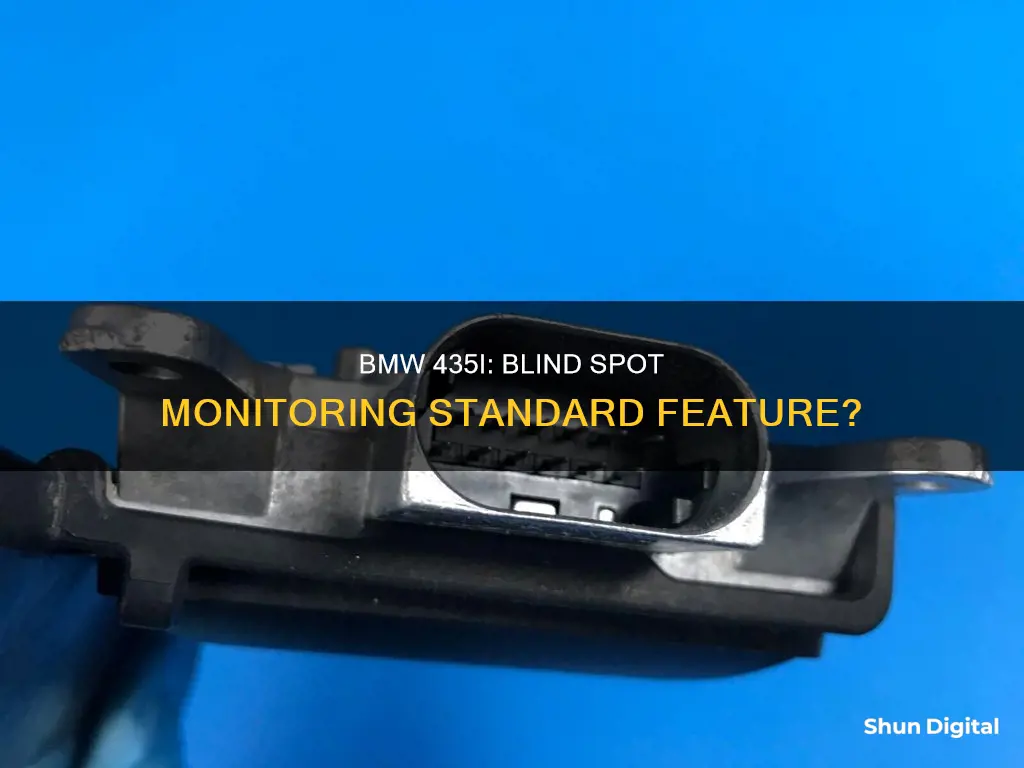
BMW's 435i model has been a popular choice for car enthusiasts, but one question that often arises is whether it comes equipped with blind spot monitoring. This feature has become increasingly important for drivers, as it enhances safety and provides extra assurance while changing lanes. While some BMW models include blind spot detection as standard, the availability of this feature on the 435i varies depending on the market, package, and production year.
In the United States, the Driver Assistance Plus package for the BMW 435i is known to include blind spot monitoring. However, some buyers have expressed confusion and disappointment upon discovering that their vehicles lacked this feature, particularly when ordering the M Sport package. This inconsistency has sparked discussions on online forums, with some attributing it to packaging limitations or technical constraints.
In Canada, the situation is slightly different. According to a few owners, the 2015 435i Gran Coupe and other 435i models around that time did not offer active blind spot detection, even as part of the Executive Package. This absence was surprising to some, as other safety features like Lane Departure and Collision Warning were included.
It's worth noting that BMW has made changes to its packages over the years, and blind spot monitoring may now be available in certain combinations for the 435i. Additionally, aftermarket blind spot monitoring systems exist, but they may not seamlessly integrate with the vehicle, and professional installation is recommended.
What You'll Learn
- The BMW 435i does not come with blind-spot monitoring as standard
- Blind-spot monitoring was available as an option on the BMW 435i
- You can install an aftermarket blind-spot monitoring system
- Aftermarket blind-spot monitoring systems are not as common as factory-installed systems
- Aftermarket blind-spot monitoring systems are universal and can be installed on any vehicle

The BMW 435i does not come with blind-spot monitoring as standard
Some owners of the 435i have expressed disappointment and frustration at not having blind-spot monitoring, considering it a vital safety feature. As a result, they have explored aftermarket solutions, but these have been discouraged by specialists as not matching the original system.
If having blind-spot monitoring is important to you, there are a few options to consider. Firstly, you could look into other packages or markets where it may be available as an option. Alternatively, you could consider a different BMW model, such as the 335i or the 428i, which have been known to offer blind-spot monitoring in certain configurations. Lastly, if you are willing to incur the expense, you could consider trading in your current vehicle for a fully-loaded 2020 model, which is likely to have this feature.
Easy Dual Monitor Setup: HDMI Connection Guide
You may want to see also

Blind-spot monitoring was available as an option on the BMW 435i
For example, one customer reported that their new 435xi, ordered with the Driver Assistance Plus package, did not include Active Blind Spot Detection, despite this feature being listed on the BMW USA website as part of the Active Driving Assistance option. Another customer in Canada reported that their fully loaded 435ix Gran Coupe did not include Active Blind Spot Detection, and that this feature was not offered in Canada at all.
Some customers have suggested that the unavailability of blind-spot monitoring is related to the M Sport package. One user stated that blind-spot monitoring was not available with the M Sport package on the 335i, while another said that it was only available with the Executive Package for the 2015 model. However, another user reported having a 2014 435i M Sport with blind-spot monitoring, so it appears that the availability of this feature may have varied by market and model year.
For customers who purchased a BMW 435i without blind-spot monitoring, aftermarket systems are available, although some shops and users have recommended against them, stating that they do not match the original system.
Connecting a Monitor to a Motherboard: A Step-by-Step Guide
You may want to see also

You can install an aftermarket blind-spot monitoring system
Aftermarket blind-spot monitoring systems are not as common as factory-installed systems, but they are expanding as more companies enter the market. These companies offer custom-designed kits for a variety of vehicles. Some of the features you'll find on an aftermarket blind-spot monitor include sonar, radar, and lidar technologies to sense the exterior environment. Some even have cameras inserted into side mirrors.
While professional installation is recommended, you can install an aftermarket blind-spot monitor yourself. Here are the general steps:
- Place the measuring tape parallel with your vehicle's wheels. Take out the calibration cloth from your system, and place it behind the vehicle at a 90-degree angle to the tape.
- Take a level and stand it vertically against the vehicle, aligning it with the calibration cloth. Use a marker to draw a straight line on the rear bumper.
- Remove the rear bumper and, if necessary, the taillights.
- Clean the calibrating positions in the inner rear bumper with a cleaning cloth and rubbing alcohol.
- Place the two magnets included in the system on the outside and inside of the vehicle on the lines you marked. Play around with the placement of the sensors—they should be at around a 20-degree angle from your vehicle's bumper.
- Mark the spot inside the bumper where the magnet rests with the marker.
- Apply adhesive to the sensors and stick them to the inside of the bumper.
- Mount the LED indicators inside your vehicle's cabin, somewhere you can easily see them without taking your eyes off the road.
- Adjust the volume to a decent level.
If you have any issues when installing your aftermarket blind-spot monitoring system, reach out to a service center to have a professional work on the installation.
Maximizing Monitor Resolution: Finding Your Screen's True Potential
You may want to see also

Aftermarket blind-spot monitoring systems are not as common as factory-installed systems
Aftermarket blind-spot monitoring systems can be a perfect addition to older vehicles that are not equipped with certain technologies. They can increase driving awareness, assist drivers of larger vehicles, prevent crashes, and increase response times.
Aftermarket systems typically consist of sensors and indicators. The sensors use a variety of technologies, such as sonar, radar, and lidar, to detect hazards in a vehicle's blind spot. Some systems also use cameras inserted into side mirrors. Once the sensor detects an object, it triggers an indicator, such as a visual LED light or an alarm.
While aftermarket blind-spot monitoring systems can be a useful addition to a vehicle, they are not a substitute for using mirrors and checking blind spots manually. It is also important to note that these systems may not match the original system offered by the vehicle's manufacturer.
In the case of the BMW 435i, some users have reported that their vehicles did not come with blind-spot detection, even when it was expected to be included. It appears that the availability of blind-spot detection may depend on the specific model, package, and market. Some BMW 435i models with the M-Sport package, for example, may not have the option to include blind-spot detection.
HDMI Ports: Are They Standard on LCD Monitors?
You may want to see also

Aftermarket blind-spot monitoring systems are universal and can be installed on any vehicle
BMW's 4-series vehicles, including the 435i, have been the subject of much discussion regarding their blind-spot monitoring capabilities. While some models do offer this feature, it appears that certain packages and vehicle configurations may exclude it. This has caused confusion and frustration among some BMW owners and prospective buyers.
Aftermarket blind-spot monitoring systems offer a universal solution that can be installed on any vehicle, including the BMW 435i. These systems are designed to work regardless of the vehicle's age, make, or model. They typically consist of sensors that use technologies such as sonar, radar, or lidar to detect objects in the vehicle's blind spots. Some systems may also include cameras mounted on the side mirrors. When an object is detected, the system alerts the driver through visual and/or audio indicators.
The installation process for an aftermarket blind-spot monitoring system typically involves the following steps:
- Calibrating the system by placing a calibration cloth behind the vehicle and marking the sensor positions on the rear bumper.
- Removing the rear bumper and cleaning the calibration positions.
- Mounting the sensors on the marked spots and connecting them to the system.
- Installing LED indicators inside the vehicle's cabin, ensuring they are easily visible to the driver.
- Adjusting the volume of the indicators to ensure they are noticeable without being startling.
Aftermarket blind-spot monitoring systems offer several benefits, including increased driving awareness, assistance for drivers of larger vehicles, crash prevention, and improved response time. These systems provide an extra set of eyes on the road, reducing stress and enhancing safety.
How LCD Monitors Handle Frequency Interference
You may want to see also
Frequently asked questions
No, the BMW 435i does not come with built-in blind spot monitoring. However, you can install an aftermarket blind spot monitoring system.
An aftermarket blind spot monitoring system is a custom-designed kit that can be installed in your vehicle to add a blind spot monitoring feature.
While professional installation is recommended, you can install an aftermarket blind spot monitoring system yourself. The process involves marking sensor placement, removing the rear bumper, cleaning the calibrating positions, placing the sensors, and mounting the LED indicators.







